This is an old revision of this page, as edited by Anonymous Dissident (talk | contribs) at 08:27, 5 September 2007 (better word). The present address (URL) is a permanent link to this revision, which may differ significantly from the current revision.
Revision as of 08:27, 5 September 2007 by Anonymous Dissident (talk | contribs) (better word)(diff) ← Previous revision | Latest revision (diff) | Newer revision → (diff) For other uses, see Lion (disambiguation).
| Lion | |
|---|---|

| |
| Male (Lion) | |
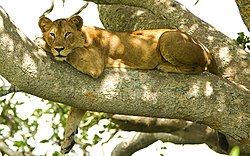
| |
| Female (Lioness) | |
| Conservation status | |
 Vulnerable (IUCN 3.1) | |
| Scientific classification | |
| Kingdom: | Animalia |
| Phylum: | Chordata |
| Class: | Mammalia |
| Order: | Carnivora |
| Family: | Felidae |
| Genus: | Panthera |
| Species: | P. leo |
| Binomial name | |
| Panthera leo (Linnaeus, 1758) | |

| |
| Distribution of Lions in Africa | |
| Synonyms | |
|
(Linnaeus, 1758) | |
The lion (Panthera leo) is a member of the family Felidae and one of four "big cats" in the genus Panthera. Reaching up to 225 kg (500 lb), it is the second-largest cat after the tiger. Although lions were once widespread throughout much of Africa, Asia, Europe, and even prehistoric North and South America, they currently exist in the wild only in sub-Saharan Africa and in Asia with a critically endangered remnant population in northwest India.
In the wild, lions live for approximately 10–14 years, while in captivity they can live over 20 years. They typically inhabit savanna and grassland, although they may take to bush and forest. Lions are unusually social compared to other cats. A lion pride consists of related females and offspring and a small number of dominant males. Groups of female lions typically hunt together, preying mostly on large ungulates. The lion is an apex and keystone predator.
The lion is a vulnerable species, having seen a possibly irreversible population decline of 30 to 50% over the past two decades in its African range. Although the cause of the decline is not well-understood, habitat loss and conflicts with humans are currently the greatest causes of concern.
The male lion is highly distinctive and is easily recognized by its mane. The lion, particularly the face of the male, is one of the most widely recognized animal symbols in human culture. It has been extensively depicted in literature, in sculptures, in paintings, on national flags, and in films, among other elements of popular culture.
Naming and etymology
The lion's name, similar in many languages, derives from the Latin leo, and before that the Ancient Greek leōn/λεων. The Hebrew word lavi (לָבִיא) may also be related, as well as the Ancient Egyptian rw. It was one of the many species originally described, as Felis leo, by Linnaeus in his 18th century work, Systema Naturae.
The generic component of its scientific designation, Panthera leo, is often presumed to derive from Greek pan- ("all") and ther ("beast"), but this may be a folk etymology. Although it came into English through the classical languages, panthera is probably of East Asian origin, meaning "the yellowish animal," or "whitish-yellow".
Physical characteristics
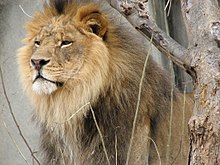
The lion is the second largest feline after the tiger. With powerful legs, a strong jaw, and long canine teeth, the lion can bring down and kill large prey. Lion coloration varies from light buff to yellowish, reddish or dark ochraceous brown. The underparts are generally lighter and the tail tuft is black. The color of the mane varies from blond to black.
Average listed weights for the male lion are between 150–225 kg (330–500 lb), and 120–150 kg (260–330 lb) for females. Nowell and Jackson report average weights of 181 kg for males and 126 kg for females. Head and body length is 170–250 cm (5 ft 7 in–8 ft 2 in) in males and 140–175 cm (4 ft 7 in–5 ft 9 in) in females; shoulder height is about 123 cm (4 ft) in males and 100 cm (3 ft 3 in) in females. The tail length is 70–100 cm (2 ft 3 in–3 ft 3 in). The tail ends in a hairy tuft. The tuft conceals a spine, approximately 5 mm long, formed of the final sections of tail bone fused together. The lion is the only felid to have a tuffed tail and the function of the tuft and spine are unknown.
Mane

The mane of the male lion, unique amongst cats, is one of the most distinctive characteristics of the species. It makes the lion look bigger than it really is, providing an excellent intimidation display; this aids him during confrontations with other lions and with the species' chief competitor in Africa, the spotted hyena. The presence, absence, color, and size of the mane is associated with genetic precondition, sexual maturity, climate and testosterone production; the darker and fuller the mane, the healthier the lion. Research in Tanzania also suggests mane length signals fighting success in male-male relationships. Darker-maned individuals may have longer reproductive lives and higher offspring survival, although they suffer in the hottest months of the year. In prides led by a coalition of two or three males, it is possible that lionesses more actively solicit mating with heavily maned lions.
Maneless lions have been reported in Senegal and Tsavo East National Park in Kenya, and the original male white lion from Timbavati was also maneless. Castrated lions have minimal manes. Manelessness is also found in inbred lion populations; inbreeding also results in poor fertility.
Scientists once believed that the distinct status of some subspecies could be justified by morphology, including the size of the mane. Morphology was used to identify subspecies such as the Barbary lion and Cape Lion. Research has suggested, however, that environmental factors influence the color and size of a lion's mane, such as the ambient temperature. The cooler ambient temperature in European and North American zoos, for example, can result in a heavy mane. Thus the mane is an inappropriate marker for identifying subspecies. However the males of the Asiatic subspecies are characterized by sparser manes than average African lions.
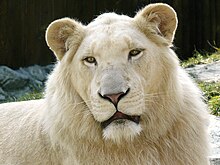
Cave paintings of european cave lions show excusively animals with no or just hinted manes, what is evidence to suggest, that these prehistoric lions where more or less maneless.
White lions
The white lion is not a distinct subspecies, but a special morph with a genetic condition that causes paler colouration akin to the black panther or white tiger. White animals of the Transvaal lion (Panthera leo krugeri) have been occasionally encountered in and around the Kruger National Park and the adjacent Timbavati Private Game Reserve in eastern South Africa, but more commonly found in captivity, where breeders deliberately select them. The unusual cream color of their coats is due to a recessive gene. They have been reportedly bred in camps in South Africa for use as trophies for canned hunts.
Biology and behaviour
Lions spend much of their time resting. They are inactive for about 20 hours per day. Although lions can be active at any time of day, their activity generally peaks after dusk with a period of socializing, grooming and defecating, followed by intermittent bursts through the night hours to dawn. Hunting takes place more often during the night hours. They spend an average 2 hours a day walking and 50 minutes eating.
Hunting and diet
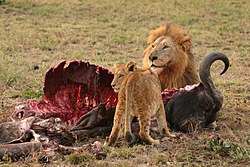
Lions usually hunt in groups. Their prey consists mainly of larger mammals, with a preference for wildebeest, impalas, zebras, buffalo, giraffes and warthogs in Africa and nilgais, wild boars and several deer species in India. Many other species are hunted based on availability, maily ungulates of a weight between 50 and 300 kg, like kudu, hartebeest, gemsbok and eland. Ocassionaly they take relatively small species like thomson's gazelle or springbok. Lions often prey on healthy, adult animals, but dare to attack buffalo bulls in their prime and fully grown male giraffes. Very large species such as hippopotamuses, rhinoceroses and elephants are generally avoided due to the danger of injury and the effort required to capture them. In some areas, lions specialise in hunting atypical prey-species; this is the case at the Savuti river, where they prey on young elephants. It is reported that the lions, driven by extreme hunger, started taking down baby elephants, and then moved on to adolescents and, occasionally, fully grown adults. Lions also attack domestic livestock, especially in the Indian range cattle contribute significantly to its diet. They are capable of killing other predators such as leopards, cheetahs, hyenas and wild dogs, as well as scavenging animals either dead from natural causes or killed by other predators. A lion may gourge itself and eat up to 30 kg (66 lb) in one sitting; if unable to consume all the kill will rest for a few hours before consuming more. On a hot day, the pride may retreat to shade leaving a male or two to stand guard. An adult female lion requires about 5 kg (11 lb) of meat per day, a male about 7 kg (15.4 lb).
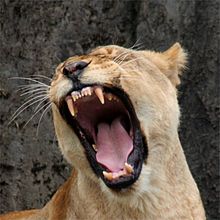

Young lions first display stalking behaviour around attempt three months of age, though do not participate in actual hunting until almost a year old. They begin to hunt effectively when they are almost two years old. Lions can reach speeds of 50 mph, though only for short bursts, so they have to be quite nearby their prey before starting the attack. Lions take advantage of factors which reduce visibility; many kills take place near some form of cover or at night. They sneak up to the victim until they reach a distance of about 30 m (98 feet) or less. Usually several lions work together and encircle the herd from different points. The attack is short and powerful, the lion attempting to catch the victim with a fast rush and final leap. The prey is usually killed by strangulation.
Because lions hunt in open spaces where they are easily seen by their prey, cooperative hunting increases the likelihood of a successful hunt; this is especially true with larger species. Teamwork also enables them to defend their prey more easily against other large predators like hyenas, which can be attracted by vultures over kilometers in open savannas. Lionesses do most of the hunting; males attached to prides do not usually participate, except in the case of large animals such as buffalo and giraffe. In group hunts, each lioness has a favored position in the group, either stalking prey on the "wing" then attacking, or moving a smaller distance in the centre of the group and capturing prey in flight from other lionesses.
Reproduction
Lions do not mate at any specific time of year, and the females are polyestrous. Like other cats, the male lion's penis has spines which point backwards. Upon withdrawal of the penis, the spines rake the walls of the female's vagina, which may cause ovulation. A female may mate with more than one male when she is in heat; during a mating bout, which could last several days, the couple frequently copulate twenty to forty times a day and are likely to forgo hunting. In captivity, lions reproduce very well.
The average gestation period is around 110 days, the female giving birth to a litter of one to four cubs. Lionesses in a pride will synchronize their reproductive cycles so that they cooperate in the raising and suckling of the young, who suckle indiscriminately from any or all of the nursing females in the pride. Cubs are usually born and initially kept hidden from view in thickets or sheltered areas. They weigh 1.2-21 kg at birth and are almost helpless, beginning to crawl a day or two after birth and walking around three weeks of age. Weaning occurs after six to seven months. In the wild, competition for food is fierce, and as many as 80% of the cubs will die before the age of two.
When one or more new males take over a pride and oust the previous master(s), the conquerors often kill any remaining cubs. This is explained by the fact that the females would not become fertile and receptive until the cubs grow up or die. The male lions reach maturity at about 3 years of age and are capable of taking over another pride at 4–5 years old. They begin to age and weaken between 10 and 15 years of age at the latest. This leaves a short window for their own offspring to be born and mature—the fathers have to procreate as soon as they take over the pride. The lioness will often attempt to defend her cubs fiercely from a usurping male, but such actions are rarely successful, as he usually kills all the previous top male's cubs that are less than two years old and the female is much lighter and has less strength than the male. However, success is more likely when a group of 3 or 4 mothers within the pride join forces against one male.
One scientific study reports that both males and females may interact homosexually. Male lions pair-bond for a number of days and initiate homosexual activity with affectionate nuzzling and caressing, leading to mounting and thrusting. A study found that about 8% of mountings have been observed to occur with other males, while female pairings are held to be fairly common in captivity but have not been observed in the wild.
Health
Though adult lions have no natural predators, evidence suggests that the majority die violently from humans or other lions. Various species of tick commonly infest the ears, neck and groin regions of most lions. Adult forms of several species of the tapeworm genus Taenia have been isolated from intestines, the lions having ingested larval forms from antelope meat.
Lions in the Ngorongoro Crater were afflicted by an outbreak of stable fly (Stomoxys calcitrans) in 1962; this resulted in lions becoming covered in bloody bare patches and emaciated. Lions sought unsuccessfully to evade the biting flies by climbing trees or crawling into hyena burrows; many perished or emigrated as the population dropped from 70 to 15 individuals. A more recent outbreak in 2001 killed six lions.
Lions are vulnerable to the Canine distemper virus (CDV), which is spread though domestic dogs and other carnivores; a 1994 outbreak in Serengeti National Park resulted in many lions exhibiting neurological features such as seizures, and succumbing.
Group organization
Lions are predatory carnivores who manifest two types of social organization. Some are residents, living in groups, called prides. The pride consists of (usually around five or six) related females, their cubs of both sexes, and a group of one to four males known as a coalition who mate with the adult females. Others are nomads, ranging widely and moving sporadically, either singularly or in pairs. Note that a lion may switch lifestyles; nomads may become residents and vice versa. The area a pride occupies is called a pride area, whereas that by a nomad is a range.
Being smaller and more agile than males, and lacking the conspicuous mane, lionesses do the pride's hunting, while the stronger males patrol the territory and protect the pride. There is no clear hierarchy with food: male lions often eat animals killed by lionesses but will never share food they have killed themselves; they will take food from cubs but are more likely to share with cubs than lionesses, which are more likely to share with each other. There is more sharing with larger kills.
Why sociality—the most pronounced in any cat species—has developed in lions is the subject of much debate. Increased hunting success appears an obvious reason, but this is less than sure upon examination: coordinated hunting does allow for more successful predation, but also ensures that non-hunting "cheaters" reduce per capita caloric intake. Other benefits include possible kin selection (better to share food with a related lion than with a stranger), protection of the young, maintenance of territory, and individual insurance against injury and hunger.
Both males and females defend the pride against intruders. Some individual lions consistently lead the defense against intruders, while others lag behind. These “laggards” are not punished by leaders. Possibly laggards provide other services to the group so that leaders forgive them. An alternative hypothesis is that there is some reward associated with being a leader who fends off intruders.
The leading male or males often have to defend against outside males attempting to take over the pride. Females form a social unit in a pride and will not tolerate outside females. Subadult males leave the pride when they reach maturity at around 2-3 years of age; some females become nomadic as well.

Communication
When resting, lion socialization occurs through a number of behaviors, and the animal's expressive movements are highly developed. The most common peaceful tactile gestures are head rubbing and social licking, which have been compared with grooming in primates. Head rubbing—nuzzling one's forehead, face and neck against another lion—appears to be a form of greeting, as it is seen often after an animal has been apart from others, or after a fight or confrontation. Males tend to rub other males, while cubs and females rub females. Social licking often occurs in tandem with head rubbing; it is generally mutual and the recipient appears to express pleasure. The head and neck are the most common parts of the body licked, which may have arisen out of utility, as a lion cannot lick these areas individually.
Lions have an array of facial expressions and body postures that serve as visual gestures. Their repertoire of vocalizations is also large; variations in intensity and pitch, rather than discrete signals, appear central to communication. Lion sounds include snarling, purring, hissing, coughing, miaowing, woofing and roaring. Lions most often roar at night; the sound, which can be heard from a distance 8 km, is used to advertise the animal's presence.
Range
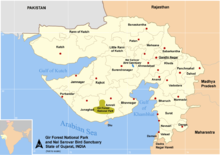
In relatively recent times the habitat of lions spanned the southern parts of Eurasia, ranging from Greece to India, and most of Africa except the central rainforest-zone and the Sahara desert. The last lions in Europe died out in historic times. A population of the Asiatic lion survived until the 10th century in the Caucasus, their last European outpost.
The species was eradicated from Palestine by the Middle Ages and from most of the rest of Asia after the arrival of readily available firearms in the 18th century. Between the late 19th and early 20th century they became extinct in North Africa and the Middle East. By the late 19th century the lion had disappeared from Turkey, while the last sighting of a live Asiatic Lion in Iran was in 1941 (between Shiraz and Jahrom, Fars province). In 1944, the corpse of a lioness was found on the banks of Karun river, Khuzestan province, Iran. There are no subsequent reliable reports from Iran. The subspecies now survives only in and around the Gir Forest of northwestern India. About 300 lions live in a 1412 km² (558 square miles) sanctuary in the state of Gujarat, which covers most of the forest. Their numbers remain stable.
Once the lion was the most widespread land mammal besides man. Until the late Pleistocene (about 10,000 years ago), lions were found in most of Africa, much of Eurasia from western Europe to India and the Bering land bridge and in the Americas from Yukon to Peru. Parts of this range were occupied by suspecies, which are extinct today. The most famous of these prehistoric subspecies were the Cave Lion (Panthera leo spelaea) and the American Lion (Panthera leo atrox).
Population and conservation status

Now, most lions live in eastern and southern Africa, and their numbers here are rapidly decreasing, with an estimated 30-50% decline over the last two decades. Currently, estimates of the African lion population range between 16,500 and 47,000 living in the wild in 2002-2004, down from early 1990s estimates that ranged as high as 100,000 and perhaps 400,000 in 1950. The cause of the decline is not well-understood, and may not be reversible. Currently, habitat loss and conflicts with humans are considered to be the most significant threats to the species. The remaining populations are often geographically isolated from each other, which can lead to inbreeding, and consequently, a lack of genetic diversity. Therefore the Lion is considered a vulnerable species by the International Union for Conservation of Nature and Natural Resources, while the Asiatic subspecies is critically endangered.
The lion population in the region of West Africa is isolated from lion populations of Central Africa, with little or no exchange of breeding individuals. The number of mature individuals in West Africa is estimated by two separate recent surveys at 850–1,160 (2002/2004). There is disagreement over the size of the largest individual population in West Africa: the estimates range from 100 to 400 lions in Burkina Faso's Arly-Singou ecosystem.
Conservation of both African and Asian lions has required the setup and maintenance of national parks and game reserves; among the best known are Etosha National Park in Namibia, Serengeti National Park in Tanzania and Kruger National Park in eastern South Africa. Outside these areas, the issues arising from lions' interaction with livestock and people usually results in the elimination of the former.
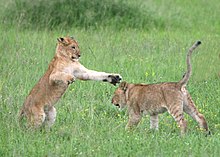
In India, the last refuge of the Asiatic Lion is the 1,412 km² (558 square miles) Gir Forest National Park in western India which had about 359 lions (as of April 2006). As in Africa, numerous human habitations are close by with the resultant problems between lions, livestock, locals and wildlife officials. The Asiatic Lion Reintroduction Project plans to establish a second independent population of Asiatic Lions at the Kuno Wildlife Sanctuary in the Indian state of Madhya Pradesh. It is important to start a second population to serve as a life insurance for the last surviving Asiatic Lions and to help develop and maintain genetic diversity enabling the species to survive.
The former popularity of the Barbary Lion as a zoo animal has meant that scattered lions in captivity are likely to be descended from Barbary Lion stock. This includes twelve lions at Port Lympne Wild Animal Park in Kent, England that are descended from animals owned by the King of Morocco. Another eleven animals believed to be Barbary lions were found in Addis Ababa zoo, descendants of animals owned by Emperor Haile Selassie. WildLink International, in collaboration with Oxford University, launched their ambitious International Barbary Lion Project with the aim of identifying and breeding Barbary lions in captivity for eventual reintroduction into a National Park in the Atlas Mountains of Morocco.
Taxonomy and evolution

The oldest fossil record of a cat closely resembling a lion is known from Laetoli in Tanzania and is perhaps 3.5 million years old; some scientists have identified the material as Panthera leo. These records are not well-substantiated, and all that can be said is that they pertain to a Panthera-like felid. The oldest confirmed records of Panthera leo in Africa are about 2 million years younger. The closest relatives of the lion are the other Panthera species, by name the tiger, the jaguar and the leopard. Morphological and genetic studies reveal, that the tiger was the first of these recent species to diverge. About 1.9 million years ago the Jaguar branched off the remaining group, which contained ancestors of the leopard and lion. The Lion and leopard subsequently separated about 1 to 1.25 million years ago from each other.
Panthera leo itself evolved in Africa between 1 million and 800,000 years ago before spreading throughout the Holarctic region; It appeared in Europe for the first time 700,000 years ago with the subspecies Panthera leo fossilis at Isernia in Italy. From this lion derived the later Cave lion (Panthera leo spelaea), which appeared about 300,000 years ago. During the upper Pleistocene the lion spread to North and South America, and developed into Panthera leo atrox, the American lion. Lions died out in northern Eurasia and America at the end of the last glaciation, about 10,000 years ago.
Subspecies
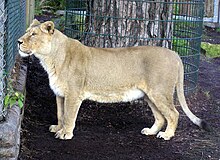

Traditionally 12 recent subspecies of lion were recognized. The major differences between these subspecies are location, mane appearance, size and distribution. Because these characteristics are very insignificant and show a high individual variability, most of these forms were debatable and probably invalid. Today usually only eight subspecies are accepted. But one of them, the Cape lion formerly described as Panthera leo melanochaita is probably invalid. Even the remaining seven subspecies might be too much, mitochondrial variation in recent African lions is modest, what suggests that all sub-Saharan lions could be considered a single subspecies, possibly divided in two main clades: one to the west of the Great Rift Valley and the other to the east. Lions from Tsavo in Eastern Kenya genetically differ minimally from lions in Transvaal (South Africa), but markedly from those in the Aberdare Range in Western Kenya.
Recent
Seven recent subspecies are recognized today:
- P. l. persica, known as the Asiatic- or South Asian, Persian or Indian lion was once widespread from Turkey, across the Middle East, to Pakistan, India and even Bangladesh. However large prides and daylight activity made it easier to poach than tigers or leopards; now around 300 currently exist in and near the Gir Forest of India.
- P. l. leo, known as the Barbary lion, is extinct in the wild, although captive individuals may still exist. This was the largest of the Lion subspecies, which ranged from Morocco to Egypt. The last wild Barbary lion was killed in Morocco in 1922 due to excessive hunting.
- P. l. senegalensis, known as the West African lion, is found in Western Africa, from Senegal to Nigeria.
- P. l. azandica, known as the North East Congo lion, is found in the Northeastern parts of the Congo.
- P. l. nubica, known as the East African- or Massai lion, is found in East Africa, from Ethiopia and Kenya to Tanzania and Mozambique.
- P. l. bleyenberghi, known as the Southwest African- or Katanga lion. South western Africa, Zimbabwe, Angola, Katanga (Zaire).
- P. l. krugeri, known as the Southeast African- or Transvaal lion, is found in the Transvaal region of South eastern Africa, including Kruger National Park.
Prehistoric
Besides these subspecies there are also some prehistoric ones.
- P. l. atrox, known as the American lion or North American cave lion, was abundant in the Americas from Alaska to Peru in the Pleistocene Period until about 10,000 years ago. This form as well as the cave lion are sometimes considered to represent separate species, but recent phylogenetic studies lead to suggest, that they are in fact subspecies of the lion (Panthera leo). One of the largest lion subspecies to have existed, its body length is estimated to have been 1.6–2.5 m (5–8 ft).
- P. l. fossilis, known as the Early Middle Pleistocene European cave lion, flourished about 500,000 years ago; fossils have been recovered from Germany and Italy. It was larger than today's African lions, with a maximum head and body length of 2.40 m (8 ft).
- P. l. spelaea, known as the European cave lion, Eurasian cave lion or Upper Pleistocene European cave lion, occurred in Eurasia 300,000 to 10,000 years ago. It is known from Paleolithic cave paintings, ivory carvings, and clay busts, indicating it had protruding ears, tufted tails, faint tiger-like stripes, and that at least some males had a "ruff" or primitive mane around their neck.
- P. l. vereshchagini, known as the East Siberian- or Beringian cave lion, was found in Yakutia (Russia), Alaska (USA), and the Yukon Territory (Canada). Analysis of skulls and mandibles of this lion demonstrate that it is distinct—larger than the European cave lion and smaller than the American cave lion with differing skull proportions.
Dubious
- P. l. melanochaita, known as the Cape lion, became extinct in the wild around 1860. Results of mitochondrial DNA research do not support the status as a distinct subspecies. It seems probable that the Cape lion was only the southernmost population of the extant southern African lion.
- P. l. sinhaleyus, known as the Sri Lanka lion, appears to have become extinct around 39,000 years ago. It is only known from two teeth found in deposits at Kuruwita. Based on these teeth, P. Deraniyagala erected this subspecies in 1939.
- P. l. europaea, known as the European lion, was probably identical with Panthera leo persica or Panthera leo spelea; its status as subspecies is unconfirmed. It became extinct around 100 AD due to persecution and over-exploitation. Inhabited the Balkans, the Italian Peninsula, southern France and the Iberian Peninsula. It was a very popular object of hunting among Romans, Greeks and Macedonians.
- P. l. youngi or Panthera youngi , known as the North-Eastern Pleistocene China cave lion, flourished 350,000 years ago. Its relationship to the extant lion subspecies is obscure, and probably represents a distinct species.
- P. l. maculatus, known as the Marozi or Spotted lion, is sometimes believed to be a distinct subspecies, but may be an adult lion that has retained its juvenile spotted pattern. If it was a subspecies in its own right, rather than a small number of aberrantly colored individuals, it has been extinct since 1931. A less likely identity is a natural leopard/lion hybrid commonly known as a leopon.
Hybrids
Lions have also been known to breed with tigers (most often the Amur and Bengal subspecies) to create hybrids called ligers and tigons. They have also been crossed with leopards to produce leopons, and jaguars to produce jaglions. The marozi is reputedly a spotted lion or a naturally occurring leopon, while the Congolese spotted lion is a complex lion/jaguar/leopard hybrid called a lijagulep. Such hybrids were once commonly bred in zoos, but this is now discouraged due to the emphasis on conserving species and subspecies. Hybrids are still bred in private menageries and in zoos in China.
The liger is a cross between a male lion and a tigress. Because the lion sire passes on a growth-promoting gene, but the corresponding growth-inhibiting gene from the female lion is absent, ligers grow far larger than either parent. They share physical and behavioural qualities of both parent species (spots and stripes on a sandy background). Male ligers are sterile, but female ligers are often fertile. Males have about a 50% chance of having a mane, but if they grow one the mane will be modest, around 50% again of a pure lion mane.
The less common tigon is a cross between the lioness and the male tiger. Because the male tiger does not pass on a growth-promoting gene and the lioness passes on a growth inhibiting gene, tigons are often relatively small, only weighing up to 150 kilograms (350 lb), which is about 20% smaller than lions. Like ligers, they have physical and behavioural traits from both parental species and males are sterile.
Lions and humans
Man-eaters
While lions usually do not attack humans, some (usually male) lions seem to seek out human prey. Well-publicized cases include the Tsavo maneaters and the Mfuwe man-eater. In both cases the hunters who killed the lions wrote books detailing the animals' predatory behavior. The Mfuwe and Tsavo incidents bear similarities: the lions in both incidents were larger than normal, lacked manes, and seemed to suffer from tooth decay. Some have speculated that they might belong to an unclassified species of lion, or that they may have been sick and could not have easily caught prey.
The infirmity theory, including tooth decay, is not favored by all researchers. An analysis of teeth and jaws of man-eating lions in museum collections suggests that, while tooth decay may explain some incidents, prey depletion in human-dominated areas is a more likely cause of lion predation on humans. In their analysis of Tsavo and man-eating generally, Peterhans and Gnoske acknowledge that sick or injured animals may be more prone to man-eating, but that the behavior is "not unusual, nor necessarily 'aberrant'" where the opportunity exists; if inducements such as access to livestock or human corpses are present, lions will regularly prey upon human beings. The authors note that the relationship is well-attested amongst other pantherines and primates in the paleontological record.
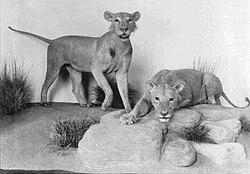
The lion's proclivity for man-eating has been systematically examined. American and Tanzanian scientists report that man-eating behavior in rural areas of Tanzania increased greatly from 1990 to 2005. At least 563 villagers were attacked and many eaten over this period—a number far exceeding the more famed "Tsavo" incidents of a century earlier. The incidents occurred near Selous National Park in Rufiji District and in Lindi Province near the Mozambican border. While the expansion of villagers into bush country is one concern, the authors argue that conservation policy must mitigate the danger because, in this case, conservation contributes directly to human deaths. Cases in Lindi have been documented where lions seize humans from the center of substantial villages.
Author Robert R. Frump wrote in The Man-eaters of Eden that Mozambican refugees regularly crossing Kruger National Park at night in South Africa are attacked and eaten by the lions; park officials have conceded that man-eating is a problem there. Frump believes thousands may have been killed in the decades after apartheid sealed the park and forced the refugees to cross the park at night. Mozambicans had for nearly a century before the border was sealed regularly walked across the park in daytime with little harm.
Packer estimates more than 200 Tanzanians are killed each year by lions, crocodiles, elephants, hippos and snakes, and that the numbers could be double that amount. Lions are thought to kill about 70 humans per year at least in Tanzania, Packer and Ikanda note. Packer and Ikanda are among the few conservationists who believe western conservation efforts must take account of these matters not just because of ethical concerns about human life, but also for the long term success of conservation efforts and lion preservation.
A man-eating lion was killed by game scouts in Southern Tanzania in April 2004. It is believed to have killed and eaten at least 35 people in a series of incidents covering several villages in the Rufiji Delta coastal region. Dr Rolf D. Baldus, the GTZ wildlife programme coordinator, is reported to have commented that it was likely that the lion preyed on humans because it had a large abscess underneath a molar which was cracked in several places. He further commented that "This lion probably experienced a lot of pain, particularly when it was chewing." GTZ is the German development cooperation agency and has been working with the Tanzanian government on wildlife conservation for nearly two decades. Like in other cases this lion was large, lacked a mane, and had a tooth problem.
The "All-Africa" record of man-eating generally is considered to be not Tsavo, but the lesser known incidents in the late 1930s through the late 1940s in what was then Tanganyika (now Tanzania). George Rushby, game warden and professional hunter, eventually dispatched the pride, which over three generations, is thought to have killed and eaten 1,500 to 2,000 in what is now Njombe district.
Tsavo and Patterson body counts vary from a confirmed 28 victims up to a possible 140. While some authors disparage the actual number, it should be kept in mind that Patterson kept firm records of skilled-labor killed by the lions, not indigenous Africans. The toll could easily have been much higher.
In captivity
| This section needs expansion. You can help by making an edit requestadding to it . |
Lions are widely seen in zoos around the world, and are one species included in the Species Survival Plan, a coordinated attempt by the Association of Zoos and Aquariums ensure its survival in captivity.
Lions were kept in a menagerie established by King John at the Tower of London in the 13th century.
Lions can reach an age of over 20 years in captivity; Apollo, a resident lion of Honolulu Zoo in Honolulu, Hawaii, died at age 22 in August 2007. His two sisters, born in 1986, are still living.
Baiting and taming

Barbary Lions were kept by Roman emperors to take part in the gladiator arenas. Roman notables, including Sulla, Pompey, and Julius Caesar, often ordered the mass slaughter of up to 400 lions at a time.
Lion-baiting is a blood sport involving the baiting of lions in combat with other animals, usually dogs. Records of it exist in ancient times through until the 17th century. It was finally banned in Vienna by 1800 and England in 1825.
Lion taming refers to the practice of taming lions for entertainment, either as part of an established circus or as an individual act, such as Siegfried & Roy. The term is also often used for the taming and display of other big cats such as tigers, leopards and cougars. The now iconic lion tamer's chair was possibly first used by American Clyde Beatty (1903–1965).
Cultural depictions
Further information: Cultural depictions of lions
The Lion has been an icon of humanity for thousands of years, appearing in cultures across Europe, Asia, and Africa. Despite incidents of attacks on humans, lions have enjoyed a positive depiction in culture as strong but noble. A common depiction is their representation as "king of the jungle" or "king of the beasts"; hence, the lion has been a popular symbol of royalty and stateliness, as well as a symbol of bravery; Richard I of England was known as Richard the Lionheart.
Representations of lions date back at least 32,000 years; the Lion man ivory carving from Vogelherd cave in the Swabian Alb in southwestern Germany has been determined to be about 32,000 years old from the Aurignacian culture. Two lions were depicted mating in the Chamber of Felines in 15,000 year old paleolithic cave paintings in the Lascaux caves. Cave lions are also depicted in the Chauvet Cave, discovered in 1994; this has been dated at 32,000 years of age, though it may be of similar or younger age to Lascaux. Ancient Egypt venerated the lion, with the Sphinx and the lion-headed deity Sekhmet; Maahes and Dedun were Egyptian deities in full lion form. The Nemean Lion was symbolic in Ancient Greece and Rome, represented as the constellation and zodiac sign Leo, and described in mythology, where its skin was borne by the hero Heracles.
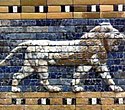
The lion was a prominent symbol in both the Old Babylonian and Neo-Babylonian Empire periods. The classic Babylonian lion motif, found as a statue, carved or painted on walls, is often referred to as the striding lion of Babylon. It is in Babylon that the biblical Daniel is said to have been delivered from the lion's den. Such symbolism was appropriated by Saddam Hussein's regime in Iraq for their Lion of Babylon tank, with the technology adapted from a Russian model.
Narasimha ("man-lion") is described as an incarnation (avatara) of Vishnu within the Puranic texts of Hinduism; who takes the form of half-man / half-lion, having a human torso and lower body, but with a lion-like face and claws. it is worshiped as "Lion God" thus Indian or Asiatic Lions which were commonly found throughout most of India in ancient times are considered sacred by all Hindus in India. Singh is an ancient Indian vedic name meaning "Lion" (Asiatic Lion), dating back over 2000 years to ancient India. It was originally only used by Rajputs a Hindu Kshatriya or military caste in India. After the birth of the Khalsa brotherhood in 1699, the Sikhs also adopted the name "Singh" due to the wishes of Guru Gobind Singh. Along with millions of Hindu Rajputs today, it is also used by over 20 million Sikhs worldwide. Found famously on numerous Flags and Coat of Arms all across Asia and Europe, the Asiatic Lions also stand firm on the National Emblem of India. Further south on the subcontinent, the lion is symbolic for the Sinhalese, Sri Lanka's ethnic majority; the term derived from the Indo-Aryan Sinhala, meaning the "lion people" or "people with lion blood", while a sword wielding lion is the central figure on the national flag of Sri Lanka.
In the medieval period in Europe, lions were frequently depicted on coats of arms, either as a device on shields themselves, or as supporters. The formal language of heraldry, called blazon, employs French terms to describe the images precisely. Such descriptions specified whether lions or other creatures were "rampant" or "passant", that is whether they were rearing or crouching.

Lions continue to feature in modern tales, from the messianic Aslan in the The Lion, the Witch and the Wardrobe and following books from the Narnia series written by C.S. Lewis, to the comedic Cowardly Lion in the The Wonderful Wizard of Oz. The word aslan is Turkish for lion.
The advent of moving pictures saw the continued presence of lion symbolism; one of the most iconic and widely recognised lions is Leo the Lion, the mascot for Metro-Goldwyn-Mayer (MGM) studios, which has been in use since the 1920s. The 1960s saw the appearance of what is possibly the most famous lioness, the Kenyan animal Elsa in the movie Born Free, based on the true-life international bestselling book of the same title. The lion's role as King of the Beasts has been utilized in cartoons, from the 1950s manga which gave rise to the first Japanese colour TV animation series, Kimba the White Lion, Leonardo Lion of King Leonardo and his Short Subjects, both from the 1960s, up to the 1994 Disney animated feature film The Lion King, which also featured the popular song The Lion Sleeps Tonight in its soundtrack.
The lion is a common symbol or epithet for sporting teams, from national soccer teams such as England, Scotland and Singapore to famous clubs such as the Detroit Lions of the NFL, Chelsea and Aston Villa of the English Premier League, (and the Premiership itself) to a host of smaller clubs around the world. Villa sport a Scottish Lion Rampant on their crest, as do Rangers and Dundee United of the Scottish Premier League.
References
- General
- Schaller, George B. (1972). The Serengeti Lion. Chicago: University of Chicago Press. ISBN 0-226-73639-3.
- Specific
- ^ Template:IUCN2006 Database entry includes a lengthy justification of why this species is vulnerable
- Simpson, D.P. (1979). Cassell's Latin Dictionary (5 ed.). London: Cassell Ltd. p. 883. ISBN 0-304-52257-0.
- Liddell, Henry George and Robert Scott (1980). A Greek-English Lexicon (Abridged Edition). United Kingdom: Oxford University Press. ISBN 0-19-910207-4.
- Simpson, J., Weiner, E. (eds), ed. (1989). "Lion". Oxford English Dictionary (2nd edition ed.). Oxford: Clarendon Press. ISBN 0-19-861186-2.
{{cite encyclopedia}}:|edition=has extra text (help);|editor=has generic name (help)CS1 maint: multiple names: editors list (link) - yourdictionary.com. As in other ancient scripts, in Ancient Egyptian only the consonants are written. No distinction was made between 'l' and 'r'.
- Template:La icon Linnaeus, C (1758). Systema naturae per regna tria naturae, secundum classes, ordines, genera, species, cum characteribus, differentiis, synonymis, locis. Tomus I. Editio decima, reformata. Holmiae. (Laurentii Salvii). p. 824.
- ""Panther"". Online Etymology Dictionary. Douglas Harper. Retrieved 2007-07-05.
- "Lion". Honolulu Zoo. Retrieved 2007-07-12.
- "BBC Wildfacts – Lion".
- ^ Nowell, K. and Jackson, P. (compilers and editors) 1996. Wild Cats. Status Survey and Conservation Action Plan. IUCN/SSC Cat Specialist Group. IUCN, Gland, Switzerland. (see Panthera Leo, pp. 17 – 21.)
- Ronald M. Nowak: Walker's Mammals of the World. Johns Hopkins University Press, 1999 ISBN 0-8018-5789-9
- Trivedi, BP (2005). "Are Maneless Tsavo Lions Prone to Male Pattern Baldness?". National Geographic. Retrieved 2007-07-07.
- ^ Trivedi, BP (Aug 22, 2002). "Female Lions Prefer Dark-Maned Males, Study Finds". National Geographic News. National Geographic. Retrieved 2007-09-01.
- ^ West, Peyton M. (2002). "Sexual Selection, Temperature, and the Lion's Mane". Science. 297 (5585): 1339–1343. Retrieved 2007-07-12.
{{cite journal}}: Unknown parameter|coauthors=ignored (|author=suggested) (help); Unknown parameter|month=ignored (help) - Trivedi, Bijal P., "To Boost Gene Pool, Lions Artificially Inseminated" in National Geographic News, 12 June 2002. Retrieved 17 July 2007.
- ^ Barnett, R., N. Yamaguchi, I. Barnes & A. Cooper. 2006. Lost populations and preserving genetic diversity in the lion Panthera leo: Implications for its ex situ conservation. Conservation Genetics.
- Yamaguchi, N. & Haddane, B. (2002). The North African Barbary lion and the Atlas Lion Project. International Zoo News 49: 465-481.
- Vivek Menon: A Field Guide to Indian Mammals, Dorling Kindersley, India, 2003. ISBN 0-14-302998-3
- ^ Koenigswald, W. v. (2002): Lebendige Eiszeit. Theiss-Verlag, ISBN 3-8062-1734-3
- McBride, Chris (1977). The White Lions of Timbavati. E. Stanton. ISBN 0-949997-32-3.
- Tucker, Linda (2003). Mystery of the White Lions - Children of the Sun God. Npenvu Press. ISBN 0-620-31409-5.
- Schaller, p. 122
- Schaller, p. 120-1
- Ronald M. Nowak: Walker's Mammals of the World. Johns Hopkins University Press, 1999 ISBN 0-8018-5789-9
- "African Lion Hunting Habits in South Africa and Southern Africa".
{{cite web}}: Unknown parameter|accessmonthday=ignored (help); Unknown parameter|accessyear=ignored (|access-date=suggested) (help) - Hayward, Matt W. and Kerley, Graham (2005). "Prey preferences of the lion (Panthera leo)". Journal of Zoology. 267 (3): 309–322. doi:10.1017/S0952836905007508.
{{cite journal}}: CS1 maint: multiple names: authors list (link) - Kemp, Leigh, "The Elephant Eaters of the Savuti." Retrieved 17 July 2007.
- Damien Whitworth (October 9, 2006). "King of the jungle defies nature with new quarry". The Australian. Retrieved 2007-07-20.
- Vivek Menon: A Field Guide to Indian Mammals, Dorling Kindersley, India, 2003. ISBN 0-14-302998-3
- Schaller, p. 213
- Guggisberg, CAW (1961). Simba. Cape Town: Howard Timmins.
- Schaller, p. 270-76
- "Lions". Honolulu Zoo. Retrieved 2007-07-20.
- Schaller, p. 153
- Schaller, p. 233
- Schaller, p. 247-8
- Schaller, p. 237
- Dr Gus Mills. "About lions - Ecology and behaviour". African Lion Working Group. Retrieved 2007-07-20.
- Stander, P. E. (1992). "Cooperative hunting in lions: the role of the individual". Behavioral Ecology and Sociobiology. 29 (6): 445–454. doi:10.1007/BF00170175.
- ^ Schaller, p. 174
- Asdell, Sydney A. (1993) . Patterns of mammalian reproduction. Ithaca: Cornell University Press. ISBN 978-0-8014-1753-5.
- Schaller, p. 142
- Schaller, p. 143
- Macdonald, David (1984). The Encyclopedia of Mammals. New York: Facts on File. p. 31. ISBN 0-87196-871-1.
- ^ Packer, C., Pusey, A. E. (1983). "Adaptations of female lions to infanticide by incoming males" (PDF). American Naturalist. 121 (5): 716–728. Retrieved 2007-07-08.
{{cite journal}}: Unknown parameter|month=ignored (help)CS1 maint: multiple names: authors list (link) - Crandall, L (1964). The management of wild animals in captivity. Chicago: University of Chicago Press.
- Bruce Bagemihl, Biological Exuberance: Animal Homosexuality and Natural Diversity, St. Martin's Press, 1999; pp.302-305. In his discussion of lion same-sex relations, Bagemihl is making use of published work by: J.B. Cooper, "An Exploratory Study on African Lions" in Comparative Psychology Monographs 17:1-48; R.L. Eaton, "The Biology and Social Behavior of Reproduction in the Lion" in Eaton, ed. The World's Cats, vol. II; pp.3-58; Seattle, 1974; G.B. Schaller, The Serengeti Lion; University of Chicago Press, 1972
-
Srivastav, Suvira (15–31 December 2001). "Lion, Without Lioness". TerraGreen: News to Save the Earth. Terragreen. Retrieved 2007-09-02.
{{cite web}}: CS1 maint: date format (link) - Schaller, p. 183
- Schaller, p. 184
- Yeoman G, Walker J (1967). The ixodid ticks of Tanzania. London: Commonwealth Inst. of Entomology.
- Template:De iconSachs, R (1969). "Untersuchungen zur Artbestimmung und Differenzierung der Muskelfinnen ostafrikanischer Wildtiere". Z. tropenmedizin und Parasitologie. 20 (1): 39–50.
- Fosbrooke, Henry (1963). "The stomoxys plague in Ngorongoro". E. Afr. Wildl. J. 1: 124–6.
- Nkwame, Valentine M (September 9 - 15, 2006). "King of the jungle in jeopardy". The Arusha Times (00435). The Arusha Times. ISSN - 9135 0856 - 9135. Retrieved 2007-09-04.
{{cite journal}}: Check|issn=value (help); Check date values in:|date=(help) - Roelke-Parker, M.E., Munson, L., Packer, C., Kock, R., Cleaveland, S., Carpenter, M., O'Brien, S.J., Pospischii, A., Hoffmann-Lehmann, R., Lutz, H., Mwamengele, G.L.M., Mgasa, M.N., Machange, G.A., Summers, B., Appel, M.J.G. (1996). "A canine distemper epidemic in Serengeti lions (Panthera leo)" (PDF). Nature. 379: 441–445. Retrieved 2007-07-08.
{{cite journal}}: Unknown parameter|month=ignored (help)CS1 maint: multiple names: authors list (link) - ^ Schaller, p. 33
- Schaller, p. 133
- Heinsohn, R. and Packer, C. (1995). "Complex cooperative strategies in group-territorial African lions". Science (269): 1260–1262.
{{cite journal}}: Cite has empty unknown parameter:|month=(help)CS1 maint: multiple names: authors list (link) - Morell, V. (1995). "Cowardly lions confound cooperation theory". Science (269): 1216–1217.
- Jahn, G. C. (1996). "Lioness Leadership". Science (271): 1215.
- Schaller, p. 37
- Schaller, p. 44
- Schaller, p. 85
- Sparks, J (1967). "Allogrooming in primates:a review". In Morris, Desmond (ed.). Primate Ethology. Chicago: Aldine. ISBN 0297748289.
- Template:De iconLeyhausen, P (1960). Verhaltensstudien an Katzen (2nd ed.). Berlin: Paul Parey. ISBN 3489718364.
- Schaller, p. 85-8
- Schaller, p. 88-91
- Schaller, p. 92-102
- Schaller, p. 103-13
- * V. G. Heptner and A. A. Sludskii: Mammals of the Sowjetunion Vol. II, Part 2 CARNIVORA (Hyaenas and Cats). Leiden, New York, 1989 ISBN 900408876 8
- Ustay, A.H. (1990). Hunting in Turkey. BBA, Istanbul.
- "Past and present distribution of the lion in North Africa and Southwest Asia". Asiatic Lion Information Centre. 2001. Retrieved 2006-06-01.
- Guggisberg, C.A.W. (1961). Simba: The Life of the Lion. Howard Timmins, Cape Town.
- Bauer H, Van Der Merwe S (2002). "The African lion database". Cat news (36): 41–53.
- Chardonnet P (2002). Conservation of African lion. Paris, France: International Foundation for the Conservation of Wildlife.
- "AWF Wildlife: Lion". African Wildlife Foundation.
{{cite web}}: Unknown parameter|retrieved=ignored (|access-date=suggested) (help) - "NATURE. The Vanishing Lions". PBS. Retrieved 2007-07-20.
- Roach, John (July 16, 2003). "Lions Vs. Farmers: Peace Possible?". National Geographic News. National Geographic. Retrieved 2007-09-01.
-
Saberwal, V. K., Gibbs, J. P., Chellam, R., Johnsingh, A. J. T. (1994). "Lion-Human Conflict in the Gir Forest, India". Conservation Biology: 501–507.
{{cite journal}}: Unknown parameter|month=ignored (help)CS1 maint: multiple names: authors list (link) - A.J.T. Johnsingh, (2004), WII in the Field: Is Kuno Wildlife Sanctuary ready to play second home to Asiatic lions? Wildlife Institute of India Newsletter, 11 (4)
- "www.totallywild.net".
- Yamaguchi N, Haddane B (2002). "The North African Barbary lion and the Atlas Lion Project". International Zoo News. 49: 465–81.
- Werdelin, Lars (2005). "Plio-Pleistocene Carnivora of eastern Africa: species richness and turnover patterns". Zoological Journal of the Linnean Society. 144 (2). The Linnean Society of London: 121–144. Retrieved 2007-07-08.
{{cite journal}}: Unknown parameter|coauthors=ignored (|author=suggested) (help); Unknown parameter|month=ignored (help) - Li Yua and Ya-ping Zhang: Phylogenetic studies of pantherine cats (Felidae) based on multiple genes, with novel application of nuclear β-fibrinogen intron 7 to carnivores. Molecular Phylogenetics and Evolution, Volume 35, Issue 2 , May 2005, Pages 483-495 online.
- Yamaguchi N, Cooper A, Werdelin L, Macdonald DW (2004). "Evolution of the mane and group-living in the lion (Panthera leo): a review". J. Zool. Lond. 263: 329–42.
{{cite journal}}: CS1 maint: multiple names: authors list (link) - A. Turner: The big cats and their fossil relatives. Columbia University Press, 1997. ISBN 0-231-10229-1
- ^ Burger, Joachim et al. (2004): Molecular phylogeny of the extinct cave lion Panthera leo spelaea. (PDF) Mol. Phylogenet. Evol. Vol.30, p.841-849.
- * V. G. Heptner and A. A. Sludskii: Mammals of the Sowjetunion Vol. II, Part 2 CARNIVORA (Hyaenas and Cats). Leiden, New York, 1989 ISBN 900408876 8
- Barnett, Ross (2006). "The origin, current diversity and future conservation of the modern lion (Panthera leo)" (PDF). Proceedings of the Royal Society. doi:10.1098/rspb.2006.3555. Retrieved 2007-09-04.
{{cite journal}}: Unknown parameter|coauthors=ignored (|author=suggested) (help) - Jean Dubach et al. Molecular genetic variation across the southern and eastern geographic ranges of the African lion, Panthera leo. Conservation Genetics 6: 15–24, 2005. online-PDF.
- Martin, P.S. (1984). Quaternary Extinctions. Tucson, Arizona: University of Arizona Press. ISBN 0-8165-1100-4.
- ^ Packer, Craig (November 2000). "When Lions Ruled France" (PDF). Natural History: 52–57. Retrieved 2007-08-27.
{{cite journal}}: Unknown parameter|coauthors=ignored (|author=suggested) (help) - Baryshnikov, G.F., Boeskorov, G., 2001. The Pleistocene cave lion, Panthera spelaea (Carnivora, Felidae) from Yakutia, Russia. Cranium 18, 7–24.
- Burger, Joachim et al. (2004): Molecular phylogeny of the extinct cave lion Panthera leo spelaea. Molecular Phylogenetics and Evolution Vol.30, p.841-849. PDF fulltext
- Kelum Manamendra-Arachchi, Rohan Pethiyagoda, Rajith Dissanayake, Madhava Meegaskumbura (2005). "A second extinct big cat from the late Quaternary of Sri Lanka" (PDF). The Raffles Bulletin of Zoology. (Supplement No. 12). National University of Singapore: 423–434. Retrieved 2007-07-31.
{{cite journal}}: Cite has empty unknown parameter:|month=(help)CS1 maint: multiple names: authors list (link) - Harington, CR (1969). "Pleistocene remains of the lion-like cat (Panthera atrox) from the Yukon Territory and northern Alaska". 6 (5): 1277–88.
{{cite journal}}: Cite journal requires|journal=(help) - Shuker, Karl P N (1989). Mystery Cats of the World. Robert Hale. ISBN 0-7090-3706-6.
- Guggisberg, CAW (1975). Wild Cats of the World. Taplinger Pub Co. ISBN 0800883241.
- Doi H, Reynolds B (1967). The Story of Leopons. New York: Putnam. OCLC 469041.
- Patterson, Bruce D. (2003). "Tooth Breakage and Dental Disease as Causes of Carnivore-Human Conflicts". Journal of Mammalogy. 84 (1): 190–196. Retrieved 2007-07-06.
{{cite journal}}: Unknown parameter|coauthors=ignored (|author=suggested) (help); Unknown parameter|month=ignored (help) - Peterhans, Julian C. Kerbis. "The Science of Man-eating". Man-eater.info. Retrieved 2007-07-07.
{{cite web}}: Unknown parameter|coauthors=ignored (|author=suggested) (help) - ^ Packer, C. (2005). "Conservation biology: lion attacks on humans in Tanzania". Nature. 436 (7053): 927–928. Retrieved 2007-07-06.
{{cite journal}}: Unknown parameter|coauthors=ignored (|author=suggested) (help); Unknown parameter|month=ignored (help) - Frump, RR (2006). The Man-Eaters of Eden: Life and Death in Kruger National Park. The Lyons Press. ISBN 1-592288-92-9.
{{cite book}}: Check|isbn=value: checksum (help) - Daniel Dickinson (October 19, 2004). "Toothache 'made lion eat humans'". BBC News. Retrieved 2007-07-20.
- Ludger Kasumuni (August 28, 2006). "Terror from man-eating lions increasing in Tanzania". IPPmedia.com. Retrieved 2007-07-20.
- "www.springerlink.com".
- Owen, James (November 3, 2005). "Medieval Lion Skulls Reveal Secrets of Tower of London "Zoo"". National Geographic Magazine. National Geographic. Retrieved 2007-09-05.
- Aguiar, Eloise (2007). "Honolulu zoo's old lion roars no more". Honolulu Advertiser. Retrieved 2007-09-04.
{{cite journal}}: Unknown parameter|month=ignored (help) - Welman, N (1994). "Lions". Alexander the Great's Home on the Web. Thomas William-Powlett. Retrieved 2007-07-08.
- Hone, William (2004) . "July". In Kyle Grimes (ed.). The Every-Day Book. University of Alabama at Birmingham. p. 26. Retrieved 2007-09-05.
{{cite book}}: External link in|chapterurl=|chapterurl=ignored (|chapter-url=suggested) (help) - Blaisdell, Warren H. (1997). "How A Lion Fight Caused England To Stop The Breeding Of Both Ring And Pit Bulldogs". American Bulldog Review. 3 (4). Retrieved 2007-09-05.
{{cite journal}}: Unknown parameter|month=ignored (help) - Feldman, David (1993). How Does Aspirin Find a Headache?. HarperCollins. ISBN 0-06-016923-0.
{{cite book}}: Cite has empty unknown parameter:|coauthors=(help) - ^ Garai, Jana (1973). The Book of Symbols. New York: Simon & Schuster. ISBN 671-21773-9.
{{cite book}}: Check|isbn=value: length (help) - Züchner, Christian (September 1998). Grotte Chauvet Archaeologically Dated. International Rock Art Congress IRAC ´98 - Vila Real – Portugal. Retrieved 2007-08-27.
{{cite conference}}: CS1 maint: location (link) - Graves, R (1955). "The First Labour:The Nemean Lion". Greek Myths. London: Penguin. pp. 465–469. ISBN 0-14-001026-2.
- Bhag-P 1.3.18 "In the fourteenth incarnation, the Lord appeared as Nrisimha and bifurcated the strong body of the atheist Hiranyakasipu with His nails, just as a carpenter pierces cane."
- Bhag-P 7.8.19-22
- Dr. McCleod, Head of Sikh Studies, Department of South Asian Studies, McMaster University, Hamilton, Ontario, Canada
- Khushwant Singh, A History of the Sikhs, Volume I
- Government of India (2005). "Know India: State Emblem". National Portal of India. National Informatics Centre. Retrieved 2007-08-27.
- Government of Sri Lanka. "Sri Lanka National Flag". Government of Sri Lanka. Retrieved 2007-08-06.
- Government of Sri Lanka. "Article 6: The National Flag". Official Website of the Government of Sri Lanka. Government of Sri Lanka. Retrieved 2007-08-06.
- "Heraldic Dictionary:Beasts". University of Notre Dame. Retrieved 2007-07-20.
- Lewis, C.S. (1950). The Lion, the Witch and the Wardrobe. HarperCollins. ISBN 0-06-023481-4.
- L. Frank Baum, Michael Patrick Hearn, The Annotated Wizard of Oz, p 148, ISBN 0-517-500868
- "TV ACRES: Advertising Mascots - Animals - Leo the MGM Lion (MGM Studios)". TV Acres.
- Adamson, George (1969). Bwana Game : the life story of George Adamson. Fontana. ISBN 0006121454.
- Adamson, Joy (2000) . Born Free: A Lioness of Two Worlds. Pantheon. ISBN 0375714383.
- "Official Website of the Detroit Lions". Detroit Lions. 2001. Retrieved 2007-07-08.
- "Chelsea centenary crest unveiled". BBC. 2004-11-12. Retrieved 2007-01-02.
{{cite news}}: Check date values in:|date=(help) - Aston Villa F.C. (2007). "The Aston Villa Crest: 2007 Onwards..." Aston Villa F.C. Retrieved 2007-08-06.
External links
- Lion: Wildlife summary from the African Wildlife Foundation
- Panthera leo (lion) from “Animal Diversity Web”
- Lion Research Center – The official website of a research group at the U. of Minnesota that has conducted extensive field research on lions and has published over 50 peer-reviewed scientific articles on lions.
- Lion Conservation Fund – A fund dedicated to the research and conservation of the lion
- Nature Documentary: "The Vanishing Lions"
Template:Link FA Template:Link FA Template:Link FA Template:Link FA Template:Link FA Template:Link FA
Categories:- IUCN Red List vulnerable species
- Lions
- Fauna of Angola
- Fauna of Botswana
- Fauna of Burkina Faso
- Fauna of the Democratic Republic of the Congo
- Fauna of East Africa
- Fauna of Ethiopia
- Mammals of Kenya
- Fauna of Namibia
- Fauna of the Sahara
- Fauna of South Africa
- Fauna of West Africa
- Fauna of Zambia
- Mammals of Africa
- Megafauna of Africa
- Mammals of India